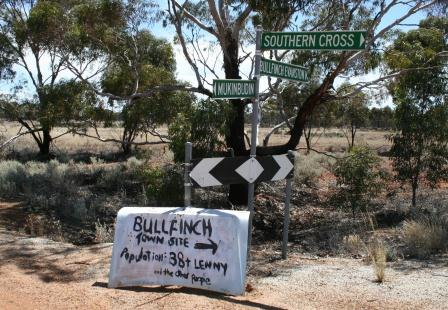Having finished our last post just yesterday saying I had no idea when we would be able to do another, here we are already! Each little place and roadhouse we’ve been through has had a signal and there have even been random moments in what seemed like the middle of nowhere when the phone has sprung into life and pinged madly as messages and emails arrived! The only conclusion we could come to was that there was a mine site lurking out there somewhere.
It seems like longer ago than yesterday morning that we left Kalgoorlie, but that is probably just because we have come quite a distance, arriving here in Eucla a day sooner than expected and as tomorrow morning will see us across the border into SA (it is only 13km away), I thought we should do out last blog entry from WA whilst we are still here!
From Kalgoorlie we travelled south to Norseman, another gold mining area, before turning right and starting the trek east. The road down to Norseman continued through the Great Western Woodlands and we really enjoyed the beautiful eucalypts we were seeing – lots and lots of gloriously flowering Coral Gums (back to the Western Flora photos to find these!), Gimlets, Salmon Gums and absolutely heaps of Goldfields Blackbutts, which are lovely trees – the contrast between the smooth white trunks and the rough, black bark of the lower part of the trunk is fantastic.
 |
| Goldfields Blackbutts. |
A large expanse of the Woodlands continued east to Balladonia and from there they become a narrow strip south of the Eyre Highway, although the landscape continued to be far more vegetated than we had expected (here I go again – more things that we didn’t expect!), going into areas of mallee and mulga and back to larger trees and on the higher ground.
We spent last night at a roadside stop between Balladonia and Caiguna and because the sun is now rising so early (about 5.20am) and WA doesn’t have daylight saving, we are awake at sparrow’s. This is very good for travelling – we were on the road by 6.45 and even though the country through which we were travelling was very interesting, there was nowhere we wanted to stop, so we kept going.
One thing that amazed us (or should I say another one – we are always being amazed) was that as we approached Madura, which is about two thirds of the way to the border, we suddenly found ourselves at the top of Madura Pass which took us down to the Roe Plains below. We had always assumed the road across the whole of the Nullarbor was very flat – demonstrates once again the danger of assuming anything! The Nullarbor is, at this stage, north of the escarpment and the Hampton Tablelands
My useful map of the Nullarbor told us one very interesting thing at this point – Madura Station was settled in 1876 and was used to breed horses for the British Army in India. Seems bizarre, although growing up in this sort of country would have made all horses very tough indeed! It also informed us that the Nullarbor, which was once part of the ocean floor, is the world’s biggest, flattest piece of limestone, covering an area of approximately 200,000 square kilometres and up to 300 metres thick. Learning all the time!
The road across to the next roadhouse, Mundrabilla and beyond travelled across the Roe Plains below the limestone escarpment - the edge of that huge piece of limestone I guess. Stopped a few kilometres after Mundrabilla for lunch and Murray went off to get a photo of the escarpment without the road sign in the way and was gone a while. He duly returned and explained that he had spied a small tent with a bit of a fly up under a tree further back in the wayside stop and thought he should go and make sure whoever was down there was OK. Turned out to be an Italian cyclist who started travelling in Darwin - today had proven to be too hot for cycling so he was sheltering from the sun and catching up on some reading!
Just 65km east of Mundrabilla we went up the Eucla Pass, ascending again to the Nullarbor Plain. So here we are tonight – perched up on top of the escarpment, looking down on the Great Australian Bight. Surprise heaped on surprise!
 |
| The view from Eucla. |
 |
| What remains of the Telegraph Station. The real question here is how on earth has that huge eucalypt behind grown in this sand? |
 |
| Looking east towards the Bunda Cliffs |
 |
| Looking west. Not sure if this jetty is the remains of one used for supplies for the Telegraph Station, but makes a good story. |
 |
| The Pied Cormorants certainly found the jetty appealing. |
 |
| And this old bird found the beach pretty appealing! |
 |
| The Delisser Sand Hills. |
Tomorrow it's into SA and who knows where we will end
up – there are lots of things to look at as soon as we get across the border, as
the highway runs very close to the Bunda Cliffs and then there is the Head of
the Bight to check out. Another blog
post in the offing!













.JPG)
.JPG)
.JPG)
.JPG)
.JPG)

.JPG)
.JPG)
.JPG)






















.JPG)
.JPG)